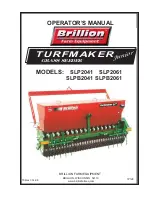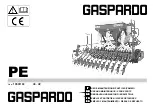
:
PELIGRO!
¡Peligro de muerte por elec-
trocución!
¡En el funcionamiento nor-
mal, el accionamiento en el
interior del devanador de hilo
tiene corriente (corriente de
soldadura)!
¡Al enhebrar el hilo desconectar el
enchufe de red de la fuente de corriente
de soldadura y garantizar que nadie
conecte la alimentación durante el el
enhebrado!
¡No tocar nunca el cable ni las piezas
bajo tensión!
ADVERTENCIA!
¡Peligro de lesiones en las
manos provocadas por las
piezas rotatorias en el deva-
nador de hilo durante el
funcionamiento!
¡No abra nunca el devanador de hilo
durante el funcionamiento normal!
¡Asegúrese de que la fuente de corriente
no esté en uso y de que no la conecte
ninguna otra persona cuando se abra el
devanador de hilo!
¡No toque nunca el accionamiento del
devanador de hilo si lo acciona con la
tapa de la carcasa abierta para realizar
un control!
ATENCIÓN!
¡Una presión demasiada alta
provoca un elevado desgaste
de los rodillos de acciona-
miento!
Ajuste la presión correcta.
¡Si el accionamiento se pone en fun-
cionamiento con una presión elevada,
se deberá controlar el desgaste de los
rodillos de accionamiento a intervalos
breves y sustituirlos en caso necesario!
I
N
F
O
El devanador de hilo deberá avanzar solo
lentamente mientras controla la presión.
¡La presión debe ajustarse de manera
que el electrodo de hilo se alimente de
forma uniforme, que no se deforme ni
se pandee!
1. Gire el tornillo de ajuste del arco de tensión
para ajustar la presión.
Se aumenta la presión
Se reduce la presión
5.8
Ajuste de la presión
:
5.
Puesta en marcha
:
DANGER!
Electric shock may be fatal!
The drive inside the wire
f e e d e r i s e l e c t r i c a l l y
energized during normal
operation (welding current)!
Pull the mains plug when threading the
wire and make sure that no one switches
the power on again during threading!
Never touch live parts or cables!
WARNING!
Risk of injury to the hands
due to rotating components
in the wire feeder during
operation!
Never open the wire feeder during nor-
mal operation!
Ensure that the wire feeder is not in
operation and that it cannot be activated
by anyone else when you open the wire
feeder!
Never reach into the drive of the wire
feeder if you are operating it with the hou-
sing cover open for inspection purposes!
CAUTION!
Excessively high applied
pressure will lead to incre-
ased wear of the drive roll!
Correctly set the applied pressure!
If you operate the drive with excessively
high applied pressure, you must check
the drive rolls for wear at shorter intervals
and replace them if necessary!
I
N
F
O
Advance the wire feeder only at slow
speed when you are checking the
contact pressure.
The contact pressure must be set for
the wire electrode to be transported
uniformly without being deformed or
kinked!
1. Turn the adjustment screw on the stirrup lock
in order to set the pressure to be applied.
Pressure force is increased
Pressure force is reduced
5.8
Adjusting the pressure force
:
5. Startup
5.8
Anpressdruck einstellen
GEFAHR!
Elektrischer Stromschlag
kann zum Tode führen!
Im normalen Betrieb steht
der Antrieb im inneren des
Drahtvorschubs unter Strom
(Schweißstrom)!
Beim Drahteinfädeln den Netzstecker der
Schweißstromquelle ziehen und sicher-
stellen, dass während des Einfädelns
niemand die Spannungsversorgung
wiederherstellt!
Niemals spannungsführende Teile oder
Kabel anfassen!
WARNUNG!
Verletzungsgefahr der Hände
durch rotierende Bauteile im
Drahtvorschub während des
Betriebes!
Öffnen Sie niemals den Drahtvorschub
während des normalen Betriebes!
Stellen Sie sicher, dass die Stromquelle
nicht in Betrieb ist und nicht durch eine
andere Person in Betrieb gesetzt wer-
den kann, wenn Sie den Drahtvorschub
öffnen!
Fassen Sie niemals in den Antrieb vom
Drahtvorschub, wenn Sie ihn zu Kontroll-
zwecken mit geöffnetem Gehäusedeckel
betreiben!
ACHTUNG!
Ein sehr hoher Anpressdruck
führt zu einem erhöhten Ver-
schleiß der Antriebsrollen!
Stellen Sie den Anpressdruck richtig ein!
Wenn Sie den Antrieb mit sehr hohem
Anpressdruck betreiben, müssen Sie die
Antriebsrollen in kürzeren Zeitabständen
auf Verschleiß kontrollieren und gegebe-
nenfalls austauschen!
I
N
F
O
Lassen Sie den Drahtvorschub nur
m i t l a n g s a m e r G e s c h w i n d i g k e i t
fördern, wenn Sie den Anpressdruck
kontrollieren.
Der Anpressdruck muss so eingestellt
werden, dass die Drahtelektrode
gleichmäßig gefördert, nicht deformiert
wird oder ausknickt!
1. Drehen Sie die Einstellschraube am Spann-
bügel, um den Anpressdruck einzustellen.
Anpressdruck wird größer
Anpressdruck wird kleiner
5. Inbetriebnahme
+
+
+
+
S c h w e i S S e n
w e l d i n g
w e l d i n g
S o l d a d u r a
S c h w e i S S e n
52


































